CATHOLICS IN THE WORLD














































































One of the highlights of my ministry as Archbishop of San Francisco is my twice-yearly visits to San Quentin State Prison in Marin County. Before the COVID-19 pandemic, I celebrated Holy Mass for the inmates there every year on Christmas Eve and then again on a Sunday in the springtime. Visiting the incarcerated is an essential activity of the Church (cf. Mt 25:36), and I am deeply grateful to all those who minister in various ways in the detention facilities of our Archdiocese. My visits to San Quentin have been a gift to me, enriching my faith and prayer life, and I eagerly look forward to when I can return to celebrate Mass there again.


Whenever I have celebrated the Holy Mass at San Quentin, I have been struck by how the inmates worship our Lord so well, with beautiful singing and great devotion, despite the hardship of incarceration. It always inspires me to see how they pour their whole heart and soul into their worship, given their difficult situation in life. Perhaps a bit ironically from the human point of view, they even seem to feel a certain kind of freedom in a most intense way at our celebrations of the Holy Eucharist.
I could not quite understand this until I took note of a unique feature in San Quentin’s Catholic chapel: the crucifix depicts Christ as we would usually see him in any of our churches, except for one large difference – his loin cloth is not the usual white garment we see painted on our images, but rather is rendered in the blue color of the prisoners’ uniforms. The message of Christ’s vesture in “prison blue” is starkly clear: the crucified Lord lovingly and intentionally identifies himself with those held in prison.
Perhaps this could be considered a sort of “inculturation” of religious art in a prison facility; either way, it certainly brings to mind the words of our Lord in the passage from St. Matthew’s Gospel referenced above (25:35-36): “For I was … in prison and you visited me.” What is more, in the Gospel of St. John, the same Lord Jesus, who makes himself one with prisoners, also identified himself with those who receive the Holy Eucharist: “Whoever eats my flesh and drinks my
www.CAcatholic.org/prop1
www.CAcatholic.org/prop1
Archbishop Salvatore J. Cordileone, shown here Dec. 24, 2016 at the Holy Door at San Quentin State Prison, named a place of pilgrimage in the Archdiocese of San Francisco for the Jubilee Year of Mercy.
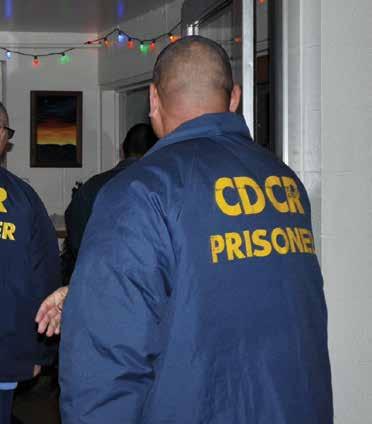

blood remains in me and I in him” (Jn 6:56). Here, then, is the connection: the devout worshippers at San Quentin understand that the one who identifies with them in their prison blues on the cross is the same one who identifies himself with them in the Eucharist at the Holy Sacrifice of the Mass, the same one whom they worship and adore with such freedom and joy.
In the Eucharist, we really receive Jesus Christ – “Body, Blood, Soul and Divinity,” as we are so fond of affirming in our Catholic tradition – and we become what we receive; we receive the Body of Christ, we become the Body of Christ. “So if it’s you that are the ›
Proposition 1 i s a worst-case scenario for abortion in California. It is an expensive and misleading ballot measure that allows unlimited lateterm abortions — for any reason, at any time, even moments before birth, paid for by tax dollars.

Proposition 1 is a worst-case scenario for abortion in California. It is an expensive and misleading ballot measure that allows unlimited late-term abortions — for any reason, at any time, even moments before birth, paid for by tax dollars.

Prop 1 isn’t needed. Sadly, California already has some of the most permissive abortion laws in the nation, but with limits on late-term abortions — which will still be allowed without the amendment for the life and health of the mother. Prop 1 destroys this limit.
California does not limit state spending on abortion, and with thousands more traveling from other states, the cost will be in the hundreds of millions. Don’t hand lawmakers a blank check to pay for abortions, and don’t let them make California an “abortion sanctuary.”
Prop 1 isn’t needed. Sadly, California already has some of the most permissive abortion laws in the nation, but with limits on late-term abortions — which will still be allowed without the amendment for the life and health of the mother. Prop 1 destroys this limit.
www.CAcatholic.org/prop1
Misleading. Expensive. Unnecessary.
California does not limit state spending on abortion, and with thousands more traveling from other states, the cost will be in the hundreds of millions. Don’t hand lawmakers a blank check to pay for abortions, and don’t let them make California an “abortion sanctuary.”
sfarchdiocese.org/noonprop1 #NoOnProp1
Proposition 1 i s a worst-case scenario for abortion in California. It is expensive and misleading ballot measure that allows unlimited lateterm abortions — for any reason, at any time, even moments before birth, paid for by tax dollars.

Prop 1 isn’t needed. Sadly, California already has some of the most permissive abortion laws in the nation, but with limits on late-term abortions — which will still be allowed without the amendment for the life and health of the mother. Prop 1 destroys this limit.
Misleading. Expensive. Unnecessary.
California does not limit state spending on abortion, and with thousands more traveling from other states, the cost will be in the hundreds of millions. Don’t hand lawmakers a blank check to pay for abortions, and don’t let them make California an “abortion sanctuary.”
sfarchdiocese.org/noonprop1 #NoOnProp1
Misleading. Expensive. Unnecessary.
www.CAcatholic.org/prop1

sfarchdiocese.org/noonprop1 #NoOnProp1
Ad paid for by The Roman Catholic Archbishop of San Francisco, a corporation sole
body of Christ and its members, it’s the mystery meaning you that has been placed on the table of the Lord,” St. Augustine teaches us. “What you receive is the mystery that means you” (Sermon 272). This is our Eucharistic faith – that Jesus Christ is sacramentally present on our altars and that he makes us his Body through the Eucharist. “The Body of Christ,” of course, is also another name for the Church, that is, the whole Church, head and members. We are, then, as St. Paul tells us, “one Body in Christ” (Rom 12:5).

Living the meaning of the Eucharist –enfleshing the mystery of the Body of Christ we receive at Mass by faithfully living as a member of the Body of Christ which is the Church – means, essentially, a life of thanksgiving, for the very meaning of the word “Eucharist” is, literally in Greek, “thanksgiving.” As Catholics, this gives us a much deeper meaning for us to the American civil holiday of Thanksgiving, now soon upon
us: we express our thanksgiving for the gift of the Eucharist by imitating our Lord’s immense divine love and carrying out the spiritual and corporal works of mercy in obedience to his commandment: “Love one another as I have loved you” (Jn 13:34). St. John Chrysostom teaches us the inseparable connection between our love for Christ in the Eucharist and our love for him in our brothers and sisters: “Would you honor the body of Christ? Do not despise his nakedness; do not honor him here in church clothed in silk vestments and then pass him by unclothed and frozen outside” (Homily 50). In other words, the only adequate response to the gift of the Eucharist is to extend Christ’s Eucharistic love to others. Because we become Christ’s members when we receive his Body, we are nothing short of Christ’s Body in the world, and so we are called to love like Christ.
“Eucharist.” “Thanksgiving.” As Catholics, every day is to be a “thanksgiving” for us who worship our Eucharistic Lord and are conformed to Him in our reception of Him. This “thanksgiving” brings the immense gifts of freedom and mercy, even as it demands that we lay down our lives for our brothers and sisters. The devout worship of the inmates of San Quentin State Prison teaches us this lesson in a concrete way, and for that I am very grateful this Thanksgiving. ■
As Catholics, every day is to be a ‘thanksgiving’ for us who worship our Eucharistic Lord and are conformed to him in our reception of him.”Photo courtesy San Quentin Prison







 BY LIDIA WASOWICZ
BY LIDIA WASOWICZ
Elizabeth Du Par was not alone as she gulped her grief watching her dying mother gasp for breath.
Neither was Lisa Hamrick during her recuperation from sickness and surgery and her mother’s losing struggle with illness and injury.

They had companions on the road to recovery or return to their Maker — hospital chaplains.
They “were there for both mom and me, especially in the final moments of her life,” related Du Par, referring to Marin Health Medical Center chaplains Father William Thornton, pastor of St. Sebastian Church in Greenbrae, and Episcopal Deacon Alberta Buller and to her former neighbor Edna Griffith, who offered support the minute she saw the ambulance arrive at Du Par’s door in the early hours of June 24, 2021, to rush her pneumonia-stricken mother to the hospital.
“I feel each one, although not previously known to her, was an angel sent by God to
walk with us,” said Du Par, who shares and seeks solace at small-group discussions on bereavement at St. Hilary Church in Tiburon.
God also sent an emissary to walk with Hamrick during her trips to the hospital for her array of ailments and her mother’s series of serious conditions and a traumatic brain injury during the last four years of her life, which ended in February.

On one occasion, the chaplain anointed and absolved Hamrick on a gurney as she was being wheeled into the operating room.
“It was a deeply moving and consoling moment in my life,” the Third Order Dominican and parishioner at St. Dominic’s Church in San Francisco confided.
She and Du Par consider hospital chaplains indispensable.
“They need to be part of the journey wherever it might lead – either to the patient’s recovery or toward death,” Hamrick said.
Chaplains agree.
“Many patients, both Catholic and non-Catholic, have spiritual needs that can’t be addressed by social workers, therapists or medical staff,” said Carmelite Father Michael Kwiecien, parochial vicar at St. Teresa of Avila Church and chaplain for 12 years at Kaiser Permanente San Francisco Medical Center, where he visited 41 patients the day he talked with Catholic San Francisco.
As representatives of Jesus, priests bring unique
benefits to the bedside, concurred Father Paulinus Iwuji of the Congregation of Sons of Mary Mother of Mercy, full-time chaplain for five years at the San Francisco VA Hospital at Fort Miley.
“Chaplains bring healing to the sick through active listening, by showing compassion and empathy, by exercising a nonjudgmental presence and by creating a safe space where patients and family can share and express their needs and desires, their worries and anxieties … so that healing can occur,” he said. “Chaplains are bearers of hope as they bring God’s comforting presence.”
Some have felt the presence sufficiently to convert or return to the fold. Hospital chaplains have performed bedside baptisms and weddings, along with administering the sacraments of reconciliation and anointing of the sick.
In one particularly poignant encounter, Father Iwuji accompanied a cancer patient fighting for life following surgery no one expected him to survive.
Over five days in the intensive care unit, the unbaptized but self-described “fallen Catholic” slowly opened his eyes and heart.
“Chaplain, God gave me this chance for a reason,” the patient tearfully realized. “If I ever get out of this hospital, the first thing I will do is get baptized.”
Father Iwuji will never forget the phone call informing him he had kept his promise.
Memorable moments and the transformative nature of his vocation make chaplaincy “priceless” to Father Ernesto Jandonero, who ministered at Kaiser medical centers in San Leandro and Fremont before being transferred Oct. 10 to the health care giant’s facility in Redwood City, where he also serves at Sequoia Hospital.
During one visit, he witnessed a woman with terminal cancer turn her anxiety and sorrow into serenity and acceptance after receiving the last rites before her chemotherapy session.
“I do not have any words to explain the mysticism of the effects of the sacraments,” Father Jandonero said.
He remembers how the patient took his hand, looked him in the eye, smiled and said, “Thank you, Father Ernie. I will see you in heaven.”
Several weeks later, her mother informed him of her daughter’s dying wish: that he officiate at her funeral.
The chaplains’ companionship has garnered particular gratitude during the restrictions and limitations on hospital visitors forced by COVID-19, said Father Teodoro Magpayo, full-time chaplain at Zuckerberg San Francisco General Hospital and Trauma Center.
Appreciation aside, accompanying the sick and absolving the sinner are the favorite parts of his job, said Father Thornton, chaplain at Marin’s main hospital who also ministers at a retirement residence and four skilled nursing facilities in the area. ›
Not every priest is cut out for a vocation that makes rigorous physical, emotional and personal demands, said Via Christi Father Raymond Tyohemba, chaplain at UCSF Medical Center at Mission Bay and administrator of St. Finn Barr Church in San Francisco.

“I was on my knees talking to this lady, and she said, ‘I’m sure you’re not a priest because a priest
would be standing over me,’” Father Tyohemba recollected. “I just smiled.”
To keep smiling, chaplains should take care of themselves as well as of their patients, Father Iwuji said.
“Take some time off to recuperate,” he advised, noting the draining nature of the job assigned – or approved in the few cases where hospitals hire the chaplain – by the archbishop for an unspecified term.
Calling to mind several priests who “preferred other jobs than being a Catholic chaplain,” Father Te Van Nguyen asked the public to “pray for priests daily (to be) faithful to our ministry.”
The director of the Vietnamese Catholic community at St. Thomas the Apostle and several other churches said he almost retired during his 17 years as a chaplain, the last eight at UCSF Medical Center at Parnassus in San Francisco, but “to be faithful to my job, I practiced to be … Jesus’ disciple in this challenge.”
“May we chaplains be worthy companions on the journey – sometimes in people’s last few moments of (life) and sometimes on their road to recovery,” Father Magpayo prayed. “Praise the Lord!” ■
Chaplains bring healing to the sick through active listening, by showing compassion and empathy, by exercising a nonjudgmental presence and by creating a safe space where patients and family can share and express their needs and desires, their worries and anxieties … so that healing can occur.”FATHER PAULINUS IWUJI, FULL-TIME CHAPLAIN AT THE SAN FRANCISCO VA HOSPITAL AT FORT MILEY Photo by Dennis Callahan Marin Health Medical Center chaplain Father William Thornton, pastor of St. Sebastian Church in Greenbrae.


Is your marriage what you want it to be? Are you struggling to express your need for your spouse? Are your children suffering from lack of communication with your partner? Has your spouse left you emotionally? Have you tried to solve problems like these and found you could not do it alone? This need has given rise to the Jesuit Institute for Family Life; a staff of competently prepared and professionally skilled marriage counselors who are Catholic in religious orientation perceiving marriage as a sacrament and whose training and interest is in dealing with the above questions and areas of growth in family living. The Jesuit Institute for Family Life provides marriage counseling, individual and couples, family counseling, and group counseling for married couples as a means to meet the need within families to value the presence of individual family members and to improve the quality of intra-family relationships. To want to value one’s spouse and family members is often quite different from actually performing in a way that effectually expresses such value. We find that new skills are often needed and old obstacles to growth must be understood and worked through before effective human relating can be realized. When we do this we relate to Christ as He said, “In you give to these brothers and sisters of mine you give to Me.” (Matthew 25:40)
:
Robert Fabing, S.J., D. Mn., M.F.T., Director

Michael Neri, Ph.D., M.F.T.
Ann Rooney, S.M., M.A., M.F.T. Marilyn Neri, M.A., M.F.T.
FOR AN APPOINTMENT
Phone 650/948-4854
Jesuit Institute for Family Life Jesuit Retreat Center 300 Manresa Way, Los Altos, California 94022 www.jiflinet.com

Crowe is a freelance writer based in Steubenville, Ohio. He and his wife, Noëlle, co-host the American Catholic History podcast. Learn more at americancathol ichistory.org.

The sudden sound jumps out up above the orchestra and interrupts the soaring notes of the altos and sopranos.
Thwap! It comes again. Again! And then again. Sixteen times in all, with no rhythm or sense. The sound of mechanical violence jars against the music, which is plaintive, joyous and even triumphant.
With each sudden, grating “thwap!” one of the 16 voices cuts off. A singer ceases singing.
The sound represents the guillotine. And the 16 silenced voices Carmelite nuns. Each is executed in turn. Each went to her death with joy in her heart and the praise of God on her lips. Only the bite of the guillotine blade ceased her singing.
Eventually the final voice is silenced. Then the assembled onlookers and soldiers, silent and horrified by what they witnessed, melt away.
What you have experienced is the arresting, gut-wrenching final scene of Francois Poulenc’s brilliant opera, “The Dialogue of the Carmelites.”
This fall, this scene of holy acceptance overcoming governmental barbarity will grace the stage of War Memorial Opera House.
But this scene of incongruous brutality –who would execute Carmelite nuns? – isn’t this the product of some conspiratorial imagination raving about coming persecution?
No, this really did happen. In Paris, France,
in 1794. The nuns who gave their lives rather than abandon the faith are known as the Martyrs of Compiègne.
Nowadays, the place where it happened –the Place de la Nation – is a rather peaceful public space in eastern Paris. The center of the square features a dramatic statue titled “The Triumph of the Republic.” But there is no monument, plaque or other marker to commemorate these 16 women, nor the rest of the 1,306 people executed here in just 44 days of June and July in 1794.
They were priests and religious, nobles and other “enemies of the state,” most of whom were only guilty of being Catholic. In 1794 the Place de la Nation was known as the Place du Trône Renversè, or the Plaza of the Overturned Throne. Even the name bespeaks the reign of disorder and chaos.
And keep in mind: this was not the only site of executions. The 10-month period of the French Revolution known as the “Reign of Terror” saw about 27,000 people die in political violence, 17,000 of them in official executions. That’s 2,700 per month, 600 per week, 86 per day, most of them in Paris.
As can be expected, the government of France isn’t eager to acknowledge such wanton bloodletting, fueled by hatred of the Catholic Church.
Memorials do exist, however. Near the Place de la Nation, Our Lady of Peace Church displays a tablet with the 1,306 names. Our Lady of Peace stands on the grounds of the ›
cemetery where those 1,306 bodies – and heads – were buried in a mass grave.
And then there is “The Dialogues of the Carmelites.” Francois Poulenc, a devout Catholic, published his opera in 1956. He based the libretto on a play by the great Catholic writer George Bernanos.
In 1957, the U.S. premiere of this 20thcentury classic happened right here in San Francisco.
place children with same-sex couples. Statues of St. Junipero Serra are coming down all over, and Catholic parishes are targeted for vandalism.
And of course, they have tried, time and again, to require the Little Sisters of the Poor to violate their Catholic faith. The Sisters have stood firm, and, thankfully, the U.S. Supreme Court affirmed their rights.
This fall, this story of government coercing the consciences of peaceful Catholic nuns returns to the War Memorial Opera House.
The occasion is the 65th anniversary of that U.S. premiere of “The Dialogues.” The timing, however. Well, the timing …
In recent years California has tried to force Catholic hospitals to provide abortions, sex reassignment surgeries and sterilizations. Catholic charities have had to cease adoption services due to state requirements that they
But the dominant culture grows ever more hostile to the faith. Leaders in government, particularly here in California, push policy after policy that is antithetical to Catholic belief. This shows no sign of letting up; indeed, growing gender confusion and battles over pronouns only show the problem getting worse.
As the Church stands firm for the dignity of the human person and authentic morality, collisions will occur.
The Martyrs of Compiègne encourage us to remain steadfast in the face of persecution.
Francois Poulenc’s masterful presentation brings their passion to life on the stage.
Hopefully, this staging of “The Dialogues” will awaken in many a new respect for religious liberty, or perhaps even conversion. ■

The Martyrs of Compiègne encourage us to remain steadfast in the face of persecution.”


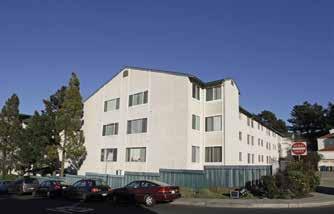

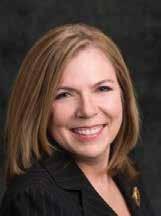
Heidi Kuhn founded Roots of Peace in 1997 to convert war-time minefields into productive agricultural land for rural farmers. She is pictured, right, in a demined Vietnam War battlefield with a local woman now growing black pepper there for export.


Louis Kolenda was living the high life as a creative director in downtown Manhattan when he had an epiphany over a bowl of room-service lobster bisque.
BY CHRISTINA GRAY Lead writer, Catholic San Francisco grayc@sfarch.org
“Is this all there is?” he asked himself, a question that changed the trajectory of his life and career.
Former flight attendant Mollie Tobias chose a new path born of a tragedy, while stay-at-home mom Heidi Kuhn catapulted to the front of a global campaign for peace.
These local lay Catholics talk about their work, which by chance, providence or intent, springs from their faith and an understanding of their fundamental partnership with God.
“I do think that a Catholic background prepares you for this type of work,” said Ed Barberini, chief of police for the City of San Mateo.
He and fellow Catholic officers Capt. Dave Peruzzaro, 50, and Lt. Todd Mefford, 52, agree that their faith and families gave them the foundation necessary to choose careers as public servants.
“I learned to treat people with compassion and respect no matter what situation they are in,” said Barberini, 52.
In a force of approximately 120 officers, about 40% are Catholic, according to Barberini.
The best and most effective cops, he said, are those that can “de-escalate” tense situations by knowing how to talk to people.
“You’re not always going to get that pat on the back,” Mefford said. The rewards of police work are a lot like the rewards of great faith. “The reward is at the end of your life.”
“I could never tolerate anyone being in pain,” said Angela Testani, who retired in 2012 after a 40-year nursing career at Mt. Zion Hospital. As a child, she cried at the sight of Christ’s feet nailed to the cross.
The Holy Name of Jesus parishioner advocated for patients by suggesting pain-saving surgical protocols to administrators. She prayed with those who noticed the cross around her neck.
After attending a workshop for Catholics on spiritual gifts, she discovered her tender heart was a reflection of the charism of mercy.
“I’d been doing what God had called me to do all along, and it fit me like a glove,” she said. “When you are truly working with the Holy Spirit, people can sense that.”
With Nigerian priest Father Edward Inyanwachi, Testani cofounded Mother of Mercy Charitable Foundation in 2016 to help alleviate the health care, educational and humanitarian needs of the rural poor in southeastern Nigeria.
A flight attendant supervisor for United Airlines, Mollie Tobias spent countless hours supporting overwrought airline workers after the terrorist attacks of Sept. 11, 2001.
“That was a really big influence in my life, trying to help people going through a major hardship,” said Tobias, who grew up in a Catholic family in Southern California.
She left United and became a licensed marriage and family therapist, today with a private practice in San Francisco under Christian
 ED BARBERINI (Shown on right)
ED BARBERINI (Shown on right)
 SAN MATEO CHIEF OF POLICE
SAN MATEO CHIEF OF POLICE
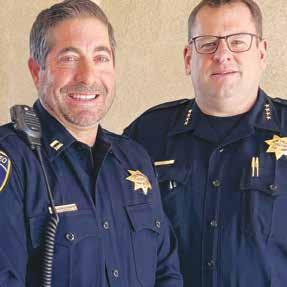
Psychotherapy Services, sfchristiancounseling.com.
“I specialize as a Catholic faith-based counselor,” she said, though she sees clients of all faiths.
“Sometimes people just want to know you have a belief in a higher power and they feel a little bit more comfortable,” she said. “Others want to be absolutely certain we share the same morals and values.”
Tobias believes in “inviting God into the therapy office.”
“I really believe God is present in our therapy session,” she said. “God can watch over and help shape and guide our conversations.”
Even as a child in Iraq, Margaret Petros said she had a “great willingness to fight injustice.”
Her Chaldean Catholic family left for the U.S. in 1979 when Iraq’s then-President Saddam Hussein demanded all Iraqi students study Islam.


Petros spent 20 years as a manager with the Santa Clara County Victim Witness Assistance Center. As a crime victim advocate, she went to bat for the legal rights of survivors of violent crime. Now as executive director of Mothers Against Murder, Petros leads a nonprofit that fights for the rights of crime survivors and their families within the criminal justice system.
“Crime victims and survivors are usually so traumatized by their violent loss that they often don’t have the energy to learn about or fight for their rights,” she said.
Victim compensation is paid with criminal ›

… a Catholic background prepares you for this type of work.”
“I don’t think I could keep going without my strong faith”
MARGARET PETROS, CRIME VICTIM ADVOCATE
I really believe God is present in our therapy session.”
MOLLIE TOBIAS, CATHOLIC THERAPIST
A parish workshop on spiritual charisms helped retired nurse Angela Testani, top row, third from left, understand her career choice. She co-founded Mother of Mercy Foundation with a Nigerian priest in 2016 to help the rural poor in Nigeria.
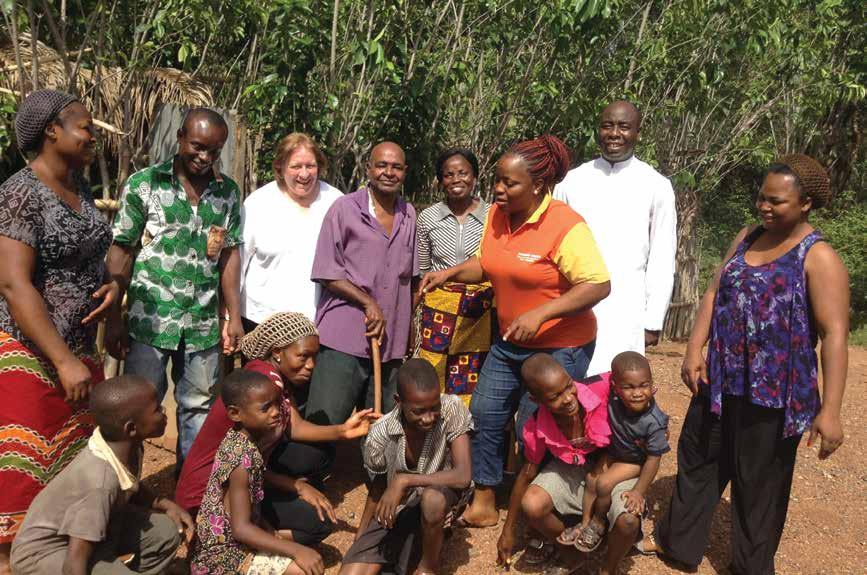
restitution funds, not tax dollars, she said, yet it is too often denied, according to Petros. The sudden need to pay for funeral, legal, medical and other expenses only “adds to the suffering” of a family reeling from the loss of a loved one to violent crime.
“When people are re-traumatized or revictimized by a violent crime as well as the system that punishes it, society pays the price,” she said.
Petros said she gets down on her knees and prays when the going gets tough. “I don’t think I could keep going without my strong faith,” she said.
Heidi Kuhn was a stay-at-home mom of four when she offered an unscripted toast to a group of landmine survivors and activists gathered at her home in San Rafael on Sept. 21, 1997.
The small delegation was in the Bay Area to support a proposed international landmine ban in the weeks after Princess Diana’s death on Aug. 31.
Diana had raised global awareness of the scourge of landmines.
“May the world go from mines to vines,” she offered in words that became an invocation of sorts.
The former international affairs reporter wondered if families who lost life, limb and livelihood because of landmines might be better able find to peace and prosperity if grapevines or orchards were planted in the former killing fields.
“It was a Holy Spirit moment,” she said. “It definitely came through me, not from me.”
Roots of Peace was founded in that moment. For the past 25 years, the humanitarian organization has been removing the remnants of war in postconflict countries and cultivating peace and prosperity to the local farmers who live there.
Louis Kolenda admitted he was “chasing money hard” as Smithsonian Magazine creative director in New York. Black-tie functions and limousine rides were all in a day’s work for the San Francisco native, who said that while he “never rebelled or veered from the faith,” his career in the business world was not totally fulfilling.
“God sent me a message,” he said of his epiphany. “It was definitely a wake-up call, like ‘It’s A Wonderful Life,’ with Jimmy Stewart.”
Kolenda returned to the Bay Area with his family and eventually went to work for Catholic radio station Relevant Radio.
Today, as executive director of YouthSF, he can be seen sporting an orange plastic safety vest on school playgrounds. The secular nonprofit is dedicated to helping underserved students participate in the digital revolution.
“An estate plan not done can rip a family apart,” said Elizabeth Button, a San Francisco probate and estate lawyer whose devout Italian Catholic grandmother factored largely in her career path.
“My Noni wanted no one to fight after she was gone,” she said. “She mapped everything out because she wanted her family to remain a family.”
Without a legal plan, mourning families are often thrown into chaos that multiplies the pain, Button said.
“It’s an interesting way of giving back,” said the St. Dunstan grade school and University of San Francisco Law School graduate. “Mercy is at the heart of it.”
Frank Lavin’s Sicilian grandparents came to San Francisco in the late 1800s, becoming a hardworking fishing family that was among those who established the city’s Fisherman’s Wharf.
“I thought a money market was like a flea market,” joked Lavin, 58, co-founder of Columbus Advisors, a small financial services firm. Its offices are steps from the wharf where his father and uncles toiled as fisherman.
Financial insecurity was a factor in his decision to become a financial adviser.
“We grew up lower-middle-class,” said Lavin, who worked his way through college at his uncles’ seafood stalls. “I wanted to make sure my family was secure and didn’t have to struggle.”
It took some time for him to see how his career is a ministry of sorts.
“People need people like me to help them manage their money and their family’s future,” he said. “God has given our lives and livelihoods to us and he asks us to take care of them,” he said.
Chris Miloslavich was station-jumping on his daily commute from Marin County to San Francisco, where he worked as an audio and video producer and editor during the 1990s.
The cradle Catholic and married father of two landed on Immaculate Heart Radio and said he was immediately “hooked.”

He said he grew up understanding the “what, but not the why” of his faith. When he learned about the Theology of the Body, St. John Paul II’s lectures on the integrated view of the human person including sexuality, “I finally understood the why,” he said.
“Catholic media is really what got me to understand my faith,” said Miloslavich, who opened his own post-production studio, Milomix, in San Rafael in 2003. “I started to feel a real call to be a part of making Catholic media better.”

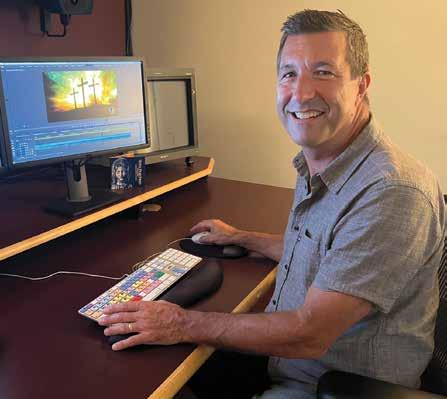
As a creative professional, he perceived of a lot of Catholic media as “unsophisticated and bland.” He founded Creative Catholic Works to help change that, offering creative services and media “through the lens of truth, beauty and goodness.” ■

Catholic media is really what got me to understand my faith.”
CHRIS MILOSLAVICH, VIDEO AND AUDIO PRODUCER

Immersed in prayer, Filipino immigrant Kyle Franz Laluces, 30, of Daly City, feels a strengthening of his lifelong love for the Church and a surging of confidence in the path he chose following a “sign” from St. Joseph.
His classmate at St. Patrick’s Seminary & University in Menlo Park, native San Franciscan Joseph McIntire, 24, is similarly intensifying his commitment to serve Jesus rather than shun Him, as he did during his embrace of atheism.
Both men attest to a deepening discernment during the inaugural “Propaedeutic Year,” an introductory course preceding formal studies launched to help prepare would-be priests for an increasingly demanding calling.
“More so than in previous generations, men aspiring to the priesthood are in need of a period of preliminary formation in which they are afforded the opportunity to focus on developing the foundations of a solid spiritual life as well as healing the wounds associated with family and societal breakdown,” said Father Mark Doherty, St. Patrick’s president-rector.
The breakdown has had caustic consequences, corroding views of men’s identity and paternal role and of vocations and the spiritual fatherhood of priests, said San Francisco Archbishop Salvatore J. Cordileone.
“There’s so much that is toxic in the culture now – and this is the culture they’ve grown up in – they need a year just to detox,” said the prelate, who began envisioning the program after observing what would become a model for St. Patrick’s at St. John Vianney Theological Seminary in Denver more than a decade ago.
Through the years, Church leaders considered steps to most effectively narrow the growing gap between secular and priestly lifestyles.
The April 2022 Vatican approval of the U.S. Conference of Catholic Bishops’ revised norms for priestly formation – called for universally by Pope Francis in 2016 – makes the preparatory period mandatory for all seminaries in the country.
“St. Patrick’s Seminary took a leadership position in being among the first seminaries to develop a program before the (governing Program for Priestly Formation) was promulgated,” said Anthony Lilles, professor of theology, former academic dean and an architect of the plan styled after the one he co-created in Denver.
Arriving on the scenic, 40-acre campus Aug. 14, 2021, the first class comprised eight candidates, ages 23 to 38, with Laluces, a parishioner at Our Lady of Mercy, and McIntire, a member of St. Stephen Parish, representing the San Francisco Archdiocese and two men each coming from the Archdiocese of Portland and the dioceses of Stockton and Spokane.
They spent the first nine months on site, residing in a ›

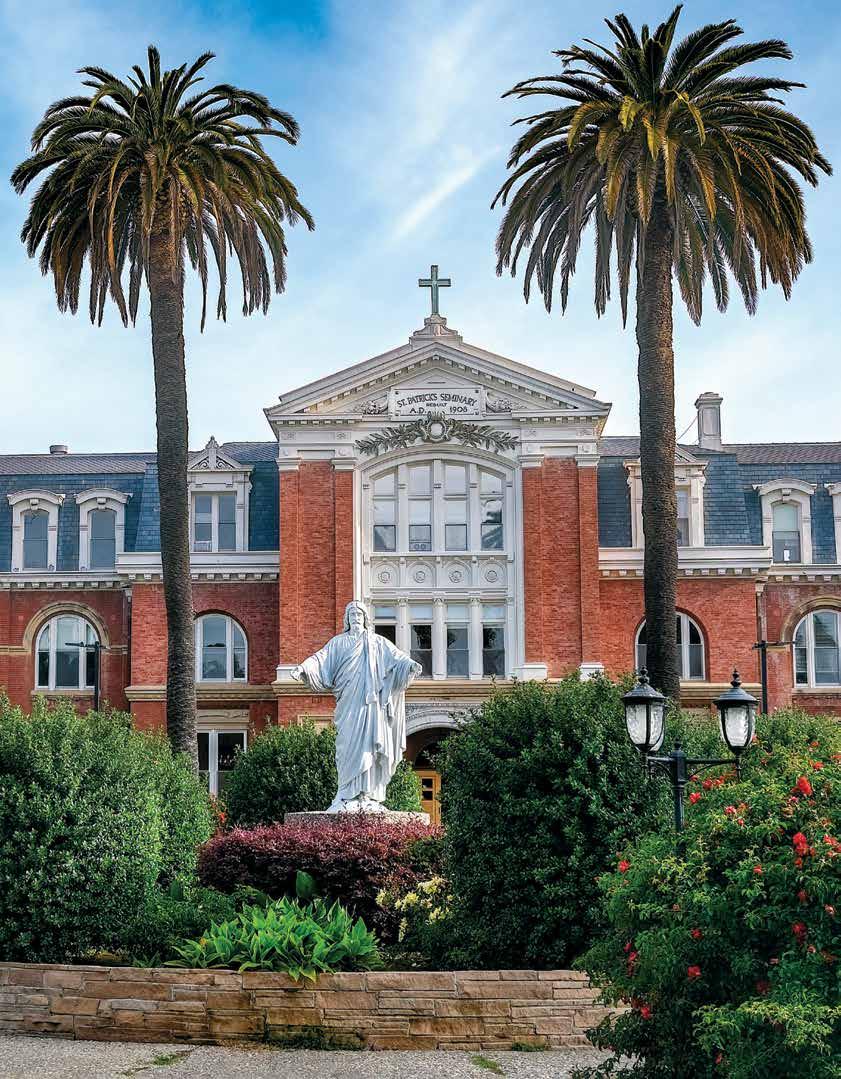
 Photos by Dennis Callahan
Photos by Dennis Callahan
seminary wing comprised of its own chapel, breakfast nook, classroom, recreation area and adjacent rooms near the quarters of program director Father Gary Thomas.
In what Laluces called “a complete game changer” and McIntire a welcome “step away from the chaos of the world,” the Propaedeutic men prayed more than two hours a day, studied, read Scripture and spiritual classics, reflected, attended liturgies, discussed theological topics ranging from God’s spiritual fatherhood to the Church’s catechism, labored manually – raking, mulching, weeding, removing and replacing 200 window screens, steam-cleaning 14 4-to-5-foot-tall outdoor Stations of the Cross – and fasted from technology and other impediments to building community and fraternity with each other and with Jesus.
Off-campus, they took on Field Education assignments. They distributed food, painted walls, sanded ceilings, administered medicine in a hospice, taught catechism to fifth graders.
The last proved the favorite activity for McIntire, a Baylor University biology graduate who espoused atheism until “some fiercely intelligent, well-catechized and virtuous Catholics who loved to argue as much as I do” pulled him “kicking and screaming” back to his childhood faith.
For Laluces, whose calling clarified with additional praying during the pandemic, the daily Holy Hour brought the greatest joy.
Having dismissed childhood friends’ predictions of Holy Orders in his future, the computer scientist who immigrated in 2016 sought a sign from St. Joseph. It came the day after his May 1, 2020, consecration to the patron saint of workers during an unexpected conversation with a former fellow student at St. Joseph Catholic School in Quezon City, Philippines.
“Out of nowhere, he goes: ‘You know Kyle, ever since we were classmates, I always thought you were gonna be a priest,’” Laluces recalled. ‘“Why didn’t you do it?’”
He was admitted to St. Patrick’s the day his pastor offered a votive Mass for Mary’s spouse. He entered the program during the Year of St. Joseph.
Laluces and McIntire also prized Sunday outings to
parishes, where they practiced meeting and greeting the congregation.
“If you’re a parish priest, a shepherd of the community, you must know how to interact with people you don’t know, especially those who may be coming to your parish for the first time,” Father Thomas said.
The group critiqued the day over pizza, burgers, Mexican food or other affordable fare.
They routinely met with Father Thomas, their spiritual adviser, a clinical psychologist and a psychiatrist for oneon-one assessment and introspection.
Discussion of topics such as discernment, communication skills, conflict management, depression, anxiety and celibacy “assisted the men with their own insights and interior growth as well as in preparation for their future ministry,” said psychiatrist Dr. Cynthia Hunt, associate director of human formation and director of counseling at St. Patrick’s.

On Saturdays and other “free” days, they traveled to San Francisco and Carmel, toured basilicas and monasteries, bowled, tossed frisbees, walked on the beach, hiked, enjoyed ice cream, played soccer and volleyball, visited family and friends and privately enjoyed the bucolic campus.
For the program’s final three months, starting May 7, they focused on pastoral formation with off-campus assignments – workshops, retreats, parish ministries, service with the Missionaries of Charity in New Mexico, a pilgrimage to Medjugorje, a healing seminar in Florida – before beginning seminary studies of pre-theology or philosophy Aug. 25.
The experiences have “done me a world of good on a personal level” and “set all of us up with a rock-solid foundation upon which, God willing, the rest of our formation is going to be built,” Laluces said.
McIntire also grew “in my desire and confidence to be a priest” and gained “a much more mature view of the priesthood, marriage and where God is calling me.”
Equally pleased, his team “could not have hoped for a better start to the program,” Father Doherty said.
For anyone who might wish to give it a try, he added: “The Lord is never outdone in generosity. If He is calling, do not be afraid to say, ‘Yes.’” ■
Photo by Dennis Callahan
































As the founder of the Contemplatives of St. Joseph, a religious family created to serve the Archdiocese of San Francisco, Father Vito Perrone always imagined creating an urban oasis where people could come and pray. When he moved into the former convent at Mater Dolorosa Parish over a decade ago, he had no idea the parish would become that place. But after being appointed pastor of the church July 1, he’s wasted no time getting to work.
Nestled in a quiet South San Francisco neighborhood in the shadow
of San Bruno Mountain, the church opens for adoration and private prayer at 6 a.m. At 7, there’s chanted lauds with the COSJ community, followed by “deep listening” to Scripture readings. Then there’s morning Mass, three hours of adoration and a midday Mass in the extraordinary form. Following an afternoon break, the church reopens for vespers, another hour of adoration and compline. The day concludes at 7 p.m. with prayers to Our Lady of Sorrows and St. Joseph and a blessing with holy water.

“People are so excited about Father

Vito,” said parish manager Fran Lidwell. “We’re getting a lot of phone calls. People are like, ‘You mean I can come in anytime? Am I free to drop in? Is it really 6 a.m.? Can I come in before work?’ And I’m like, ‘Yes, yes, yes.’”


While Mater Dolorosa’s daily schedule seems dramatic, Father Perrone said it’s actually quite straightforward and places the parish on a more monastic schedule of prayer. The ›


People just want to refresh their spirituality, and it doesn’t take much, because people are longing for it. That’s what I’m witnessing in this parish.”
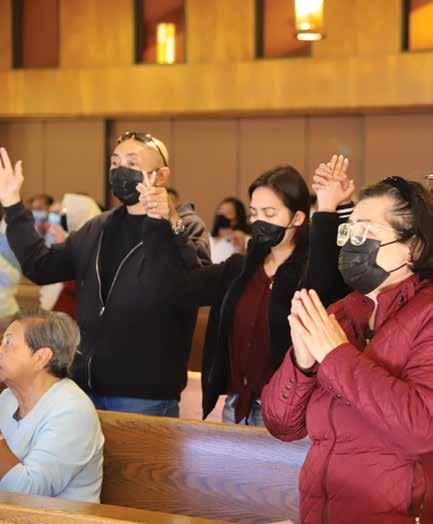

 FRAN LIDWELL, PARISH MANAGER
FRAN LIDWELL, PARISH MANAGER



religious used to chant the Divine Office and pray before the Blessed Sacrament in their private monastery chapel across the parking lot. Now they do the same things in the church sanctuary – and the whole parish is invited. “We want everybody to come and join us,” Father Perrone said in a recent interview.
By January, Father Perrone expects to have enough Eucharistic adorers to keep the church open all day, and he’s aiming for round-the-clock adoration within three years. “This is our way of serving the whole parish, of creating an atmosphere where they can come for five minutes, 10 minutes or 10 hours,” he said. “It’s just a place to stop and be touched in their soul by Christ in the Eucharist.”
Among the people swept into service at Mater Dolorosa by Father Perrone’s appointment is Third Order COSJ member Betti Magoolahan, a licensed marriage and family therapist hired to provide free short-term therapy for parishioners. “There’s so much human formation that needs to take place, mixed with the spiritual formation,” said Father Perrone. “We’re probably the only parish that’s doing this, but I can see it for sure taking place much more.”
Father Perrone is already a familiar face, says director of religious education Felisa Cepeda, having helped out with Masses and confessions at the parish for years. The kids’ burning question is about the new pastor’s different outfit.


“It’s nice to have a religious order, especially one with sisters, visible in the community,” Cepeda said. “I grew up with the Sisters of Mercy. But these kids and these families, they haven’t had that experience. We talk about vocations to religious life, but people don’t know what religious life is.”
Father Perrone always felt a strong call to the contemplative life. As a young man, he read deeply in the mystical tradition, and before becoming a diocesan priest in San Francisco, he seriously discerned a vocation to monastic life. While ›

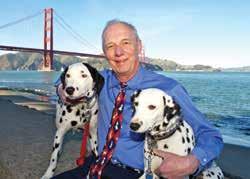

serving at different Bay Area parishes in the early 2000s, he maintained a strong personal prayer life, but still felt the desire for “a more focused life of contemplation and prayer.”
It was on a pilgrimage to St. Joseph’s Oratory in Montreal, where he found himself unexpectedly alone during a blizzard, that the idea of forming a new contemplative community within the Archdiocese came to him. In 2010, after a half-decade of discernment, he received then-Archbishop George H. Niederauer’s blessing and moved into the Mater Dolorosa convent building and started fixing it up.

His first companion, Father Joseph Homick, COSJ – who this year became parochial vicar at Mater Dolorosa – arrived in 2012. The following year, Archbishop Salvatore J. Cordileone made the COSJ a public clerical association of the Christian faithful, a formal step toward the formation of a religious order. A third order for laypeople launched a few years later, and since 2018, the COSJ has also welcomed female religious vocations. Although the community is currently small, Father Perrone expects it to grow now that it has a long-term home.
Today, COSJ members serve in active
apostolates including at St. Patrick’s Seminary & University and with the Missionaries of Charity. Before the pandemic, their monthly healing Mass incorporating the oil used by St. André Bessette (which they plan to relaunch later this year) typically attracted approximately 150 people. The community also has the unique distinction of celebrating the Byzantine Divine Liturgy as well as the ordinary and extraordinary forms of the Mass.
Recognizing that adoration, contemplative spirituality and liturgical diversity are new to many lay Catholics, Father Perrone plans to hold workshops on these and other topics. People are eager to engage with what he’s offering, Lidwell said.
“I think it’s kind of contagious, our response to God,” she said. “I think a lot of the time we’re yearning for a deeper relationship with God and more time in prayer. But we oftentimes need a pastor to say, ‘There’s more Eucharistic adoration, why don’t you come?’
Or ‘We’re going to have vespers, why don’t you show up?’ Sometimes that’s what we need. People just want to refresh their spirituality, and it doesn’t take much, because people are longing for it. That’s what I’m witnessing in this parish.” ■
Today, Contemplatives of St. Joseph members serve in active apostolates including at St. Patrick’s Seminary & University and with the Missionaries of Charity.Photo by Debra Greenblat
Contemplative of St. Joseph Father Joseph Homick in the monastery chapel.
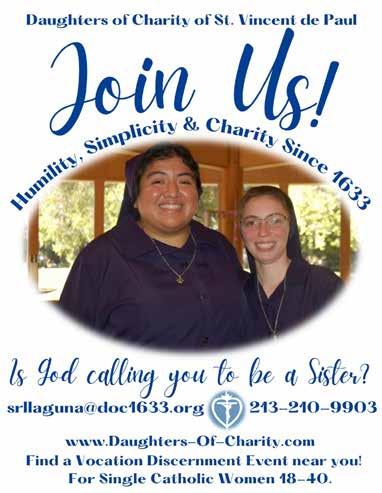

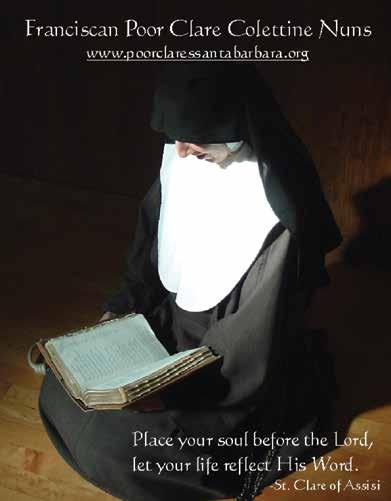


On a sunny day in April, staff and volunteers with the Archdiocese of San Francisco Restorative Justice Ministry arrived at San Quentin State Prison to take part in a victim-offender dialogue that aims to build empathy among men who have committed violent crimes including homicide.
The reentry program led by the nonprofit California Reentry Institute enlisted volunteers from the Archdiocese of San Francisco’s Restorative Justice Ministry to share their stories with the prisoners at the state’s maximumsecurity prison located in Marin County.
After going through security and being guided across the prison grounds, past the men playing soccer and lifting weights, the group arrived in the portable trailer that would serve as a classroom, taking their places in front of about 30 men.
Volunteers Ramon and Patricia Marquez and Michael Patrick had agreed to share their stories for one of the sessions of this prerelease program, which is designed to help inmates build empathy and understanding of their past actions through in-depth workshops over the course of several years.
“For the prisoners, it gives them an opportunity by listening to what it is when someone is harmed … and what it is that someone has to go through, living with the loss of a human being, especially in a homicide,” explained Julio Escobar, archdiocesan restorative justice coordinator.
He explained that victim-offender dialogues like this offer an opportunity for encounter, which is one of the steps of the restorative justice process. They are also preparation for a direct dialogue between the victim and offender of a specific incident, if such an event is to occur. “I think that both parties are empowered by the encounter that they have and that more healing is provided for them,” Escobar said.
As the session began, the Marquezes told the story of their son Michael, whom Ramon described as “a very gentle person, a very good son.”
Michael was walking home from the park with some friends one night in 2014 when a group of people came up to them and demanded his cell phone and backpack. They ended up shooting and killing him. His parents learned this the next morning after being called to the hospital. They were told that his body had already been removed as part of the investigation.
“We couldn’t see him again until he was in a casket,” Patricia Marquez said emotionally.
“A piece of you has died,” added Ramon Marquez, as men around the room teared up.
The couple spoke about the difficulty not just of facing grief at the loss of their son, but of their interactions with law enforcement officials who often seemed unconcerned.
“Dealing with the justice system, it’s very impersonal,” said Patricia.
The case is still unsolved. Both parents stressed that they don’t feel vengeful, saying that would dishonor their son. However, they would like to know that the responsible party has realized the harm done so that others wouldn’t be affected by such loss.
“Have you changed? Have you made amends?” Ramon imagined saying to the perpetrator. If the person had done so, “that would be a consolation to me.”
Patrick also shared his story as a self-described “old beachnik surf bum.”
His life was changed when he was a young man living in Maui, surfing and working as a bartender. One night he was driving across the island to meet a friend when a drunk driver hit him. He was pinned in the car for three-anda-half hours before being transferred to the hospital, where he remained for 42 days.
Although he was eventually able to recover and become a chiropractor, the injuries led to many more surgeries and joint replacements over the years.
“I’m pretty much a robot at this point,” he joked. Despite his lighthearted comments, Patrick acknowledged that the accident affected his life in ways that are emotionally difficult, preventing him from being as active as he would have liked and leading to an early retirement when his body could no longer handle the workload.
“Me and God had a lot of screaming matches down the freeway with the windows rolled down,” he shared.
He said he found it difficult to forgive the drunk driver, who already had multiple DUIs at the time of the accident, but said, “Everyone deserves another chance, even the guy who hit me.”
As part of this program, the guest speakers will be invited back for a follow-up session, where the men will be able to talk with them directly, although this has been delayed by COVIDrelated quarantines at the prison. Although the inmates did not speak at this first session, they did have the opportunity to submit written questions and comments, some of which were read at the end of the day.

“I want to thank you for Michael. I never knew him, but because of your story I miss him too,” one note said.
“Hearing about him makes me want to be more like him,” said another.
Escobar said past sessions of this type of program have elicited grateful responses as well. “The reaction is very positive, and most, I want to say all, of the prisoners are very thankful for us to bring this opportunity to them because they gain a different perspective of the victim, and this empowers them,” he said.
In the day’s closing prayer, he emphasized, “Whether you’re going to be released or not, know that our Creator has not abandoned you.” ■


The Blessed Virgin Mary stands alongside her beloved Son as one of the most revered figures in all of human history. And how could she not? God the Father chose her out of all of humanity and eternity to bear His only begotten Son so that whoever believed in Him would not perish, but have eternal life. She birthed and nurtured love Himself, mankind’s only means of salvation, and offered her entire life in worship to Him.
While the biblical narratives surrounding Mary and the rich tradition of the Church are certainly more than adequate in fostering devotion to her, Mary has been the subject of several films both new and old that do a good job of bringing her humanity to life. Moreover, some of these films can be viewed while meditating on a particular devotion or title of Mary. Here are four Marian films which can aid in deeper devotion to the Blessed Mother.
Every great story has a beginning, and there may be no greater beginning than the one ordained by God Himself as He sent His angel Gabriel to the Virgin Mary on that fateful night, who proclaimed that the Holy Spirit would overshadow her and she would bear the savior of the world as His mother. Many films have been made about the Nativity, but 2006’s “The Nativity Story” is notable not only because of its cast, but also because it was the first film to ever have its world premiere at the Vatican.
While some scenes in this movie do not portray a purely Catholic Mariology, young newcomer Keisha Castle-Hughes does a great job of
portraying a young and innocent Mary (true to history, Castle-Hughes was only 16 years old at the time of filming), and she stars alongside a fresh-faced Oscar Issac of “Star Wars” and “Dune” fame who plays St. Joseph in one of his first major roles. Though it’s only rated PG, this is perhaps one of the grittier takes on the Nativity, as the film opens with the massacre of the innocents by King Herod.
The Marian meditation to focus on during this film is the Annunciation because it recounts the immediate events in Mary’s life following her fiat – her “yes” to God. To step out in faith and become fully submissive to the Lord as Mary did is something that does not come easily, and we would each do well to follow after Our Blessed Mother’s example in listening to the Lord’s will for our lives, even in the face of impossible odds. As Mary shows, it is precisely in those seemingly impossible situations that God makes all things possible –and brings about a good far greater than we could ever imagine.
“The Passion of the Christ” is rightly esteemed as one of the greatest films about Jesus Christ. However, in true Marian fashion, it is also a film that reverently pays respects to the Blessed Mother and the suffering she endured during Jesus’ passion. For this reason, the film can in fact be viewed as a beautiful meditation on Our Lady of Sorrows, who is near us in our own suffering.
Throughout the film, Mother Mary, who is portrayed beautifully by Maia Morgenstern, is ever-present but always pointing toward her Son. The film’s most moving scenes are the ones that feature Mary, in her motherhood, alongside Jesus. She watches helplessly while her Son is scourged, she follows her maternal
instincts and runs to Jesus as He falls while carrying His cross and He says to her, “Behold Mother, I make all things new,” and, in the penultimate scene of the film, she holds her Son’s lifeless body in her arms and her sorrowful eyes pierce the viewer’s soul, as if to say, “He did this for you.”
Our Lady knew what it was to suffer, but her faith in her Son never faltered. “The Passion of the Christ” illustrates this profound spiritual reality quite poignantly.
The Scriptures don’t reveal much about what the remaining years of Mary’s life following Christ’s death were like, but thankfully Church tradition provides rich devotions and meditations to illumine that time. For those who have lost a loved one or feel alone or isolated, Our Lady of Solitude is a deep comfort.
The 2015 film “Full of Grace” is a moving and meditative movie on Our Lady’s final years before her assumption into heaven. It is a film that is contemplative in nature, even described by the director as a “cinematic prayer.” Mary is portrayed by Bahia Haifi, who brings a wisdom and tenderness befitting of her role as the Mother of God. The Gospel tells us that Jesus gave His mother to John at the foot of the cross, but it only makes sense that Mary and Peter would also share a special relationship, seeing as how Christ left it up to him to determine how to build His Church on earth. The film focuses on the relationship between Mary and Peter, the former of whom serves as a source of strength and guidance to the latter.
While devotions to Our Lady of Solitude are traditionally associated with Mary in her loneliness on Holy Saturday, it is also a fitting meditation for a film such as “Full of Grace.” There is a thread of ›
the


be

longs
Since the apparitions more than 100 years ago, the message of Our Lady of Fatima is as relevant as it ever has been, made all the more so with Russia’s ongoing war in Ukraine. Earlier this year, Pope Francis consecrated Russia to the Immaculate Heart of Mary, thus fulfilling one of Our Lady’s prophetic proclamations to the three young shepherds in Fatima, Portugal, in 1917.

Given these timely occurrences, it’s well worth revisiting the story of Our Lady of Fatima, and the 2020 film “Fatima” recounts the story well.

Set against the backdrop of World War I in Europe and the rise of the Soviet Union, Our Lady of Fatima appeared at precisely the right time. Elegantly portrayed by Portuguese actress Joana Ribiero, she appeared to the young Lucia, Jacinta and Francisco on the 13th of every month beginning in May and implored them to pray the rosary fervently for world peace and an end to the war. Through ominous visions of hell and destruction, she warns the children about the tragedies that could befall humanity if it doesn’t turn away from its sinful ways and toward her Son, Jesus Christ.
Indeed, the world has been wracked with many tragedies over the past 100 years, and some might say that hell has manifested itself on earth through these countless tragedies. However, there’s a reason that devotion to Our Lady of Fatima endures to this day, and it’s because amid all the wars and violence and injustices, Our Lady carries an everlasting message of hope that can never be blotted out. As she told young Lucia during her first apparition, “you will have much to suffer, but the grace of God will be your comfort.” May Our Mother always draw near to us in our suffering and lead us to comfort and consolation within her Immaculate Heart. ■
Editor’s Note: This reflection on the Eucharist by Venerable Fulton Sheen is part of a series by Catholic authors and saints that will be published by Catholic San Francisco Magazine as part of the U.S. Catholic Church’s Eucharistic Revival (eucharisticrevival.org) that began June 19, on the feast of Corpus Christi, and continues through Pentecost 2025. In this reflection, Venerable Fulton Sheen discusses some reasons why a holy hour, time spent in front of the Blessed Sacrament, is important.
BY VENERABLE ARCHBISHOP FULTON SHEENOne of the first effects of praying a daily holy hour will be to get rid of any evil that is in our life. Evil is not always to be overcome by combating it directly. St. Paul even suggests that certain types of mortification do not do away with certain sins.
How do we get rid of evil? By the expulsive power of a new affection. We do not drive out the evil, rather we crowd it out. We drive it out when we attack it directly. We crowd it out when we bring something else in. It’s like a man who leads an evil life until he meets a fine woman who leads him in the path of virtue. So St. Paul says: “Be not overcome by evil but overcome evil with good.”
How do we know for example that water is polluted? We know it from clean, clear water. Why are we shocked at bad grammar? Because we know good grammar. Why are we shocked at bad music? Because we know harmonious music.
Our spiritual life must not start with a deep consciousness of our guilt and sin. No. It is Christ that gives us a consciousness of guilt. He is first. Then we become aware of the fact that we have sinned against him.

Another reason for praying the holy hour is that we need power. Power is born of silence and presence. As the psalmist put it: “Be still and know that I am God.” In prayer, we shrug off the burdens of the world. We come in and spend an hour with the Lord and talk to him and listen and develop our senses of hearing and seeing and
touching. Hearing: not doing all the talking. “Speak, Lord, thy servant heareth.” Not listen, Lord, they servant speaketh. And the Lord does talk to us. ■
Excerpted from “Through the Year with Fulton Sheen: Inspirational Readings for Each Day of the Year.” Compiled and edited by Henry Dieterich, Ignatius Press, 2003. Original edition, 1985, Servant Books.
 CNS PHOTO/COURTESY PONTIFICAL MISSION SOCIETIES IN THE U.S.
CNS PHOTO/COURTESY PONTIFICAL MISSION SOCIETIES IN THE U.S.
 BY
BY
I
n October and November, the Church reflects on the gift of the rosary and the glory to come for those who remain faithful to Christ and close to Him through the grace of the sacraments.

Walking through the life of Jesus with Mary in the rosary, one sees the foundation of the Holy Spirit’s work in the world through the Church. According to the Catechism of the Catholic Church, “Jesus’ words and actions during His hidden life and public ministry were already salvific, for they anticipated the power of His paschal mystery. The mysteries of Christ’s life are the foundations of what He would henceforth dispense in the sacraments, through the ministers of His Church, for ‘what was visible in our Savior has passed over into His mysteries’” (1115).
At St. Elizabeth Catholic Church in San Francisco, the mysteries of the rosary become interlaced with the seven sacraments. With intricately painted stained glass, the remarkably detailed windows depict the joyful, sorrowful and glorious mysteries of the rosary, as well as the sacraments –Baptism, Penance, Holy Communion, Confirmation, Holy Orders, Matrimony and Anointing of the Sick.
“The stained-glass windows at St. Elizabeth Church, representing the seven sacraments and the rosary
mysteries, proclaim silently and eloquently the good news, drawing people to contemplate the divine presence,” said Father Charles Puthota, pastor at St. Elizabeth Parish. “Art, architecture, paintings and other forms of aesthetics make the Author of Beauty alluring and irresistible.”
Established as a mission church in 1912, the current structure was built in 1960 and dedicated in 1961 by Archbishop John J. Mitty. In addition to the grand stained-glass windows on the sides of the main church, stained-glass windows of Sts. Elizabeth, Zachariah and John the Baptist grace the church entrance.
The windows were ordered from the renowned Harry Clarke Studios in Ireland. While Harry Clarke passed away in 1931, one of his apprentices, William Dowling, was in touch with then-pastor Father Arthur Cantwell to design the windows for the new parish. Dowling had just worked with St. Bridget’s in San Francisco on their stained-glass windows.
According to the research of Paul Donnelly, a letter between the two men was found with Father Cantwell noting, “The first three windows have been installed and they are of such beauty of color and design and workmanship that we are at a loss of words to express our great appreciation of them. Thank you is the most inadequate word to express so much but it is entirely heartfelt.”
No doubt parishioners and visitors alike over the past 60 years have echoed Father Cantwell’s words of gratitude for the awe-inspiring windows at St. Elizabeth’s. ■
@ArchdioceseSF @sfarchdiocese sfarch.org/signup @sfarchdiocese /ArchdioceseofSanFrancisco
@ArchdioceseSF @sfarchdiocese sfarch.org/signup @sfarchdiocese /ArchdioceseofSanFrancisco @ArchdioceseSF @sfarchdiocese sfarch.org/signup @sfarchdiocese /ArchdioceseofSanFrancisco @ArchdioceseSF @sfarchdiocese sfarch.org/signup @sfarchdiocese /ArchdioceseofSanFrancisco @ArchdioceseSF @sfarchdiocese sfarch.org/signup @sfarchdiocese /ArchdioceseofSanFrancisco @ArchdioceseSF @sfarchdiocese sfarch.org/signup @sfarchdiocese /ArchdioceseofSanFrancisco @ArchdioceseSF @sfarchdiocese sfarch.org/signup @sfarchdiocese /ArchdioceseofSanFrancisco @ArchdioceseSF @sfarchdiocese sfarch.org/signup @sfarchdiocese /ArchdioceseofSanFrancisco @ArchdioceseSF @sfarchdiocese sfarch.org/signup @sfarchdiocese /ArchdioceseofSanFrancisco @ArchdioceseSF @sfarchdiocese sfarch.org/signup @sfarchdiocese /ArchdioceseofSanFrancisco @ArchdioceseSF @sfarchdiocese sfarch.org/signup @sfarchdiocese /ArchdioceseofSanFrancisco @ArchdioceseSF @sfarchdiocese sfarch.org/signup @sfarchdiocese /ArchdioceseofSanFrancisco @ArchdioceseSF @sfarchdiocese sfarch.org/signup @sfarchdiocese /ArchdioceseofSanFrancisco @ArchdioceseSF @sfarchdiocese sfarch.org/signup @sfarchdiocese /ArchdioceseofSanFrancisco @ArchdioceseSF @sfarchdiocese sfarch.org/signup @sfarchdiocese /ArchdioceseofSanFrancisco @ArchdioceseSF @sfarchdiocese sfarch.org/signup @sfarchdiocese /ArchdioceseofSanFrancisco @ArchdioceseSF @sfarchdiocese sfarch.org/signup @sfarchdiocese /ArchdioceseofSanFrancisco @ArchdioceseSF @sfarchdiocese sfarch.org/signup @sfarchdiocese /ArchdioceseofSanFrancisco @ArchdioceseSF @sfarchdiocese sfarch.org/signup @sfarchdiocese /ArchdioceseofSanFrancisco @ArchdioceseSF @sfarchdiocese sfarch.org/signup @sfarchdiocese /ArchdioceseofSanFrancisco
@ArchdioceseSF @sfarchdiocese sfarch.org/signup @sfarchdiocese /ArchdioceseofSanFrancisco @ArchdioceseSF @sfarchdiocese sfarch.org/signup @sfarchdiocese /ArchdioceseofSanFrancisco
@ArchdioceseSF @sfarchdiocese sfarch.org/signup @sfarchdiocese /ArchdioceseofSanFrancisco
@ArchdioceseSF @sfarchdiocese sfarch.org/signup @sfarchdiocese /ArchdioceseofSanFrancisco
@ArchdioceseSF @sfarchdiocese sfarch.org/signup @sfarchdiocese /ArchdioceseofSanFrancisco
@ArchdioceseSF @sfarchdiocese sfarch.org/signup @sfarchdiocese /ArchdioceseofSanFrancisco
@ArchdioceseSF @sfarchdiocese sfarch.org/signup @sfarchdiocese /ArchdioceseofSanFrancisco
@ArchdioceseSF @sfarchdiocese sfarch.org/signup @sfarchdiocese /ArchdioceseofSanFrancisco
@ArchdioceseSF @sfarchdiocese sfarch.org/signup @sfarchdiocese /ArchdioceseofSanFrancisco
@ArchdioceseSF @sfarchdiocese sfarch.org/signup @sfarchdiocese /ArchdioceseofSanFrancisco
@ArchdioceseSF @sfarchdiocese sfarch.org/signup @sfarchdiocese /ArchdioceseofSanFrancisco
@ArchdioceseSF @sfarchdiocese sfarch.org/signup @sfarchdiocese /ArchdioceseofSanFrancisco
@ArchdioceseSF @sfarchdiocese sfarch.org/signup @sfarchdiocese /ArchdioceseofSanFrancisco
@ArchdioceseSF @sfarchdiocese sfarch.org/signup @sfarchdiocese /ArchdioceseofSanFrancisco
@ArchdioceseSF @sfarchdiocese sfarch.org/signup @sfarchdiocese /ArchdioceseofSanFrancisco
@ArchdioceseSF @sfarchdiocese sfarch.org/signup @sfarchdiocese /ArchdioceseofSanFrancisco
@ArchdioceseSF @sfarchdiocese sfarch.org/signup @sfarchdiocese /ArchdioceseofSanFrancisco
@ArchdioceseSF @sfarchdiocese sfarch.org/signup @sfarchdiocese /ArchdioceseofSanFrancisco
@ArchdioceseSF @sfarchdiocese sfarch.org/signup @sfarchdiocese /ArchdioceseofSanFrancisco
@ArchdioceseSF @sfarchdiocese sfarch.org/signup @sfarchdiocese /ArchdioceseofSanFrancisco
@ArchdioceseSF @sfarchdiocese sfarch.org/signup @sfarchdiocese /ArchdioceseofSanFrancisco
@ArchdioceseSF @sfarchdiocese sfarch.org/signup @sfarchdiocese /ArchdioceseofSanFrancisco
@ArchdioceseSF @sfarchdiocese sfarch.org/signup @sfarchdiocese /ArchdioceseofSanFrancisco









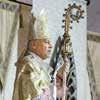


We hope our readers are enjoying this edition of Catholic San Francisco Magazine. A lot of thought, preparation and heart have gone into our new publication.
A great deal of support has come from our advertisers. They have expressed excitement about a beautifully designed magazine that will be delivered 8 times each year to our current readership. Featured stories will inspire an appreciation for our faith and concurrently offer real assistance that will improve our lives in a myriad of ways.



“You my dear brothers and sisters are the force of order in our city,” Archbishop Cordileone said at the Mass at the Cathedral of St. Mary of the Assumption held on the anniversary of the Sept. 11, 2001 terrorist attacks. “We thank you for the great risks you take with your lives every day, every day to ensure order and our protection,” Archbishop Cordileone told the assembled men and
women in uniform before blessing the first responders’ stars and shields with holy water.

The memorial Mass honors those who have died in the previous year, and all first responders in San Francisco. The Mass was first offered in 1947, following the Herbert Hotel fire that killed four firefighters. ■




to the Hebrews
Peter (with “The”)
What you do not use in unleavened bread
Chi follower
Dismas, the Good ___
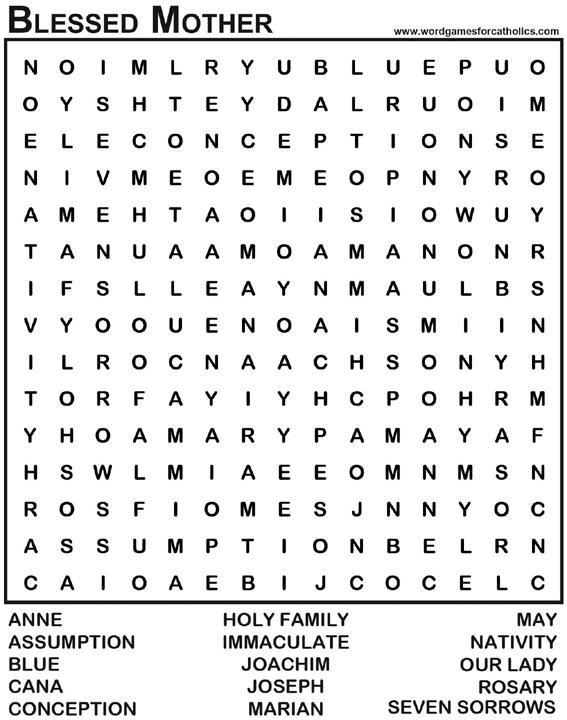
“…thy kingdom ___”
State in which the Diocese of Dallas is found
“Likewise, you shall not pick your vineyard ____...these things you dhall leave for the poor and the alien” (Lev 19:10)

Blend of oil and balsam
Jesus, on the third day
He gave Hannah words of comfort
Father of Cain
Arrival of the Magi
Character in one of Jesus’ parables
It was empty Easter morning
“___ homo”
Martha, to Mary
He gave up his birthright to his brother
“Light from light, ___ God from…”
Commits a capital sin
“…___ to anger, abounding in mercy” (Ps 103:8)
___ in the Garden
OT book
First word in the name of a Parisian basilica
“…an assembly of nations, will stem from you, and kings will ___ from your loins.” (Gen 35:11)
Number of Persons in God
Diocese of Honolulu greeting
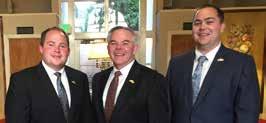
She saved Joshua’s spies
He walked with God
Judas’ blood money bought it
“…and a ___ for every affair under the heavens” (Eccl 3:1)
Patron of Australia, St. Francis ___
Wife of Abram
Jesus entered Jerusalem this type of animal
Adam was made from this
Doctrines
OT historical book
Volcano in the Italian Ecclesiastical Province of Catania
Lic.# 025401
Trusted In-Home care. Hourly & 24 hr. Live-in. Hygiene assistance. Meal prep., housekeeping and errands/shopping. Low rates/free 1st day off. Bonded & insured. 415-960-7881 / 925-330-4760 / 650-580-6334

Button Law Inc.
Elizabeth M. Button, Trust & Estate Attorney

Probates * Wills * Trusts
Sensitive to those Struggling with Loss. Serving the Entire Bay Area Woman Owned & Operated Free consultations. 1052 Filbert Street San Francisco, CA 94133 Call Today: (650) 703-6038 www.buttonlawsf.com
The Department of Catholic Schools of the Archdiocese of San Francisco, is seeking elementary principal candidates for the 2023-2024 school year. Candidates must be a practicing Roman Catholic in good standing with the church, possess a valid California Standard Teaching Credential or the equivalent from another state, a Master’s Degree in an educational field and/or California administrative credential or the Certificate in Catholic School Administration from Loyola Marymount University *, be certified as a catechist at the basic level** and have five years of experience in teaching and/or in administration with Catholic school experience.


*Principals who are not in possession of both educational qualifications, must complete the requirement within a three year period of time from date of hire.
** Principals who are not in possession of basic certification in religion at the time of hire, must complete the process before they start their position.
Application materials may be downloaded from the official DCS website by visiting: www.sfarch.org/employment.
The requested material plus a letter of interest should be submitted before Feb. 28 to: Christine Escobar, Human Resources Manager Department of Catholic Schools One Peter Yorke Way, San Francisco, CA 94109
Salary will be determined according to archdiocesan guidelines based upon experience as a teacher or administrator and graduate education. Medical, dental, and retirement benefits are included.
(415) 614-5506 This number is answered by Rocio Rodriguez, LMFT, Archdiocesan Pastoral Outreach Coordinator. This is a secured line and is answered only by Rocio Rodriguez.
(415) 614-5503 If you wish to speak to a non-archdiocesan employee please call this number. This is also a secured line and is answered only by a victim survivor.
(800) 276-1562 Report sexual abuse by a bishop or a bishop’s interference in a sexual abuse investigation to a confidential third party. www.reportbishopabuse.org
The Archdiocese of San Francisco adheres to the following policy: “All school staff of Catholic schools of the Archdiocese of San Francisco shall be employed without regard to race, color, sex, ethnic or national origin and will consider for employment, qualified applicants with criminal histories.” (Administrative Handbook #4111.4)
All employees of the Archdiocese of San Francisco shall be employed without regard to race, color, sex, ethnic or national origin and pursuant to the San Francisco Fair Chance Ordinance, will consider for employment qualified applicants with criminal history.*Principals who are not in possession of both educational qualifications, must complete the requirement within a three year period of time from date of hire.
JP LANDSCAPING & GARDENING
License #319526
Clean up, Weed Removal Lawn Services, Trimming Fences and Cement Serving SF; 415-664-1199

VALLOMBROSA CENTER Conferences and meetings, Retreat and spirituality programs.
Private person seeking to buy a used car, truck and RV Call Grant: 415.517.5977
TO THE BLESSED VIRGIN NEVER KNOWN TO FAIL
ST. JUDE NOVENA
May the Sacred Heart of Jesus be adored, glorified, loved & preserved throughout the world now & forever. Sacred Heart of Jesus pray for us. St. Jude helper of the hopeless pray for us. Say prayer 9 times a day for 9 days. Thank You St. Jude. Never known to fail. You may publish. T
Landscaping, Demolition, Hauling, Moving, Janitorial Call Grant: 415-517-5977



CARE
CLAIRE’S IN-HOME CARE
SENIOR CARE SERVICE Irish Caregiver San Francisco / Peninsula Days / Evenings / Nights 650-255-5165 cjtreacy@aol.com



Overnight accommodations 250 Oak Grove Avenue Menlo Park, CA 94025 www.vallombrosa.org 650-325-5614 www.biroandsons.com
Most beautiful flower of Mt. Carmel Blessed Mother of the Son of God, assist me in my need. Help me and show me you are my mother. Oh Holy Mary, Mother of God, Queen of Heaven and earth. I humbly beseech you from the bottom of my heart to help me in this need. Oh Mary, conceived without sin. Pray for us (3X). Holy Mary, I place this cause in your hands (3X). Say prayers 3 days. T
Nov. 1: Solemnity of All Saints (Holy Day of Obligation)
Nov. 3-5: 2022 Faith Formation Conference: “Gratefully Rejoicing as the Body of Christ.” To view a complete list of speakers & scheduled events and to register, go to hopehealrenew.org
Nov. 12: Mother/ Daughter Programs, St. Bartholomew Parish, 9 a.m.- 5 p.m. sfarch.org/ marriage-and-family-life
Nov. 18-20: Life-Giving Wounds Healing Retreat for Adult Children of Divorced and Separated Parents, Vallombrosa Retreat Center. sfarch.org/ marriage-and-family-life
Nov. 19: Memorial Mass and Healing Service for Miscarriage and Infant Loss, St. Dominic’s Church, 10 a.m.
Dec. 3: Cruzada Guadalupana pilgrimage walk and 2 p.m. Mass at St. Mary’s Cathedral
Dec. 8: Solemnity of the Immaculate Conception (Holy Day of Obligation)
Dec. 24: Carol Service and Midnight Mass (St. Mary’s Cathedral)
Dec. 25: Christmas (Holy Day of Obligation)
Jan. 21, 2023: 2023 Walk for Life. walkforlifewc.com
 BY ROD LINHARES Director of Mission Advancement for the Archdiocese of San Francisco.
BY ROD LINHARES Director of Mission Advancement for the Archdiocese of San Francisco.

Alifelong Catholic, Ed Reidy was baptized at Our Lady of Mercy in Daly City, and he’s been a member of St. Stephen Parish in San Francisco since 1967. After attending high school at St. Ignatius High School in the City (class of ’76), he went to Santa Clara University, where he played rugby and football. Reidy credits his Catholic upbringing and education for establishing a strong foundation, instilling a deep sense of community and being integral to the person he is today. “We were taught the need to participate in something greater than ourselves,” he said.
After a long career with PepsiCo that took him around the world, Reidy came back to San Francisco and immersed himself in the community. In addition to his active role at St. Stephen’s, he serves on the board of directors (including time as the board chair) of the Janet Pomeroy Center in San Francisco, which provides recreational, vocational and educational opportunities for people with disabilities. He is also an emeritus board member of the Olympic Club, where he’s been a member for 51 years, and is integrally involved with its foundation, supporting sports-related nonprofits that provide resources to underserved communities.
In addition, Reidy is a member of St. Ignatius’ Admiral Callaghan Society, which mentors students and encourages pursuit of service-related roles, including the U.S. military, and he’s volunteered in San Francisco’s Tenderloin neighborhood with the St. Vincent de Paul Society to assist the homeless there. Quite simply, his commitment to the community is deep and a great inspiration.
It is because of the Church’s influence on his life that Reidy wanted to leave a gift in his estate to the Archdiocese of San Francisco. He used FreeWill, a free service provided by the Archdiocese, to do so. “It is really important to provide a legacy and help the generations to come. FreeWill made it simple and easy,” Reidy said.
Estate planning is especially important for Catholics. We are called to act as stewards for our lives and our futures so we can reach future generations with the Church’s message of faith, love and hope.
Estate plans help protect your assets, make your wishes known and make certain that control of your health and safety decisions is in your own hands. It’s critical to have a plan to support your loved ones and the things you’ve worked hard for.
“People don’t do enough to protect themselves or their loved ones,” Reidy said.
Many people believe that a will isn’t necessary due to their age or size of their estate. But whether you’re 18 or 80, everyone should consider their future and the ramifications on their loved ones. Do you have an estate plan in place?
FreeWill can make the essential task of creating a will easier. In less than a half hour, you can protect what matters most – at no cost. You also have the opportunity to create a legacy gift by supporting the parish, school or ministry of your choice – thereby strengthening our Catholic community, as Reidy noted, “for generations to come.” ■
Get peace of mind and leave a bequest to your parish, school, or the Archdiocese … create or update your will for FREE in just 20 minutes

O n t h e o c c a s i o n o f t h e






we extend our sincere gratitude to the Catholic Community worldwide for planting the Roots of Peace on Earth...
T h r o u g h y o u r g e n e r o u s d o n a t i o n s , w e h a v e f a c i l i t a t e d t h e r e m o v a l o f m i l l i o n s o f l a n d m i n e s / U X O ’ s a n d p l a n t e d m i l l i o n s o f f r u i t t r e e s i n A f g h a n i s t a n , A n g o l a , B o s n i a - H e r z e g o v i n a , C a m b o d i a , C r o a t i a , I r a q , I s r a e l , P a l e s t i n e a n d V i e t n a m .
T h r o u g h y o u r g e n e r o u s d o n a t i o n s , w e h a v e f a c i l i t a t e d t h e r e m o v a l o f m i l l i o n s o f l a n d m i n e s / U X O ’ s a n d p l a n t e d m i l l i o n s o f f r u i t t r e e s i n A f g h a n i s t a n , A n g o l a , B o s n i a - H e r z e g o v i n a , C a m b o d i a , C r o a t i a , I r a q , I s r a e l , P a l e s t i n e a n d V i e t n a m .
L a n d m i n e s a r e c u r r e n t l y b e i n g l a i d i n U k r a i n e , a n d o u r w o r k i s m o r e c h a l l e n g i n g t h a n e v e r .
L a n d m i n e s a r e c u r r e n t l y b e i n g l a i d i n U k r a i n e , a n d o u r w o r k i s m o r e c h a l l e n g i n g t h a n e v e r .
P l e a s e D O N A T E : w w w . r o o t s o f p e a c e . o r g
P l e a s e D O N A T E : w w w . r o o t s o f p e a c e . o r g


Whatever your task, work heartily, as serving the Lord and not men, knowing that from the Lord you will receive the inheritance as your reward; YOU ARE SERVING THE LORD CHRIST. COLOSSIANS 3:23-24



